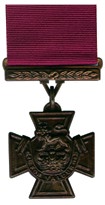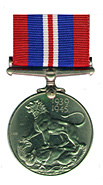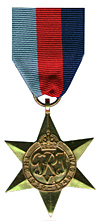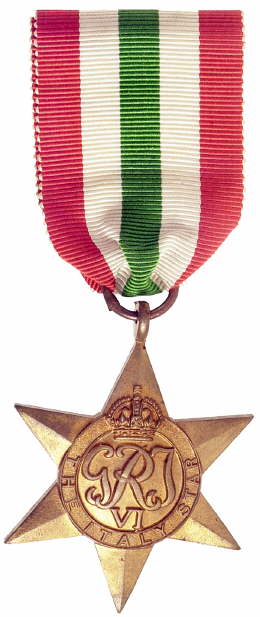 |
The Victoria Cross
(Valour) |
"This decoration is possibly the the most renowned of any in the world, its simplicity belying the unequivocal acts of bravery required to receive a bestowal of this award. From its inception [in] 1856, it has become progressively more difficult to win, to such an extent that up until 1987, only 1,354 Crosses and three first Bars have been awarded. The last two Crosses were posthumous awards for the attack on Goose Green by the Paras in the Falkland's conflict. In fact the Cross is becoming almost always a posthumous award.
... Queen Victoria's Prince Consort Albert first suggested the award to reward the bravery of troops in the Crimea for which no other distinction existed. The design of the Cross is attributed to H.H. Armstead, although reference has been made [that] Prince Albert had a great hand in it's development... It is usually made from the barrels of Russian guns captured in the Crimean War. However, during the First World War, it is [suggested] that the Cross was produced from Chinese cannon. It is also believed that the [supply of] bronze from the Russian guns [was] exhausted in 1942.
...The design of the Cross has not changed during its life, but the ribbon has, initially awards to the Navy had a dark blue ribbon and those of the Army a crimson one. However, with the introduction of the RAF as a formal arm of Britains military forces [in] 1918, it was decided that the Victoria Cross should be the highest award rendered to all three services and [that] the ribbon should be the same for each service. It was deemed appropriate that the Crimson ribbon be the one [adopted].
...The Cross was issued named, and in the case of those awarded during the Second World War, name, rank, serial number and unit are engraved in plain capitals on the reverse of the bar, while the date of the award is engraved in three lines on the central medallion. For subsequent awards, a Bar similar to that of the sudspension bar was added as a slip-on. [..] There were 182 awards of the Cross and one first Bar during the Second World War. The Cross can be conferred upon officers, non-commissioned officers and men of all three armed forces as well as members of the merchant marine and auxiliary forces under military command. Women are also eligible for the awars, although none have so far received one. Civilians can also be awarded the Cross if they are caught up in fighting and come under the control of the armed forces.
The original warrant was extended [in] 1920, with the words of qualification, 'Most conspicuous bravery or some daring or pre-eminent act of valor or self-sacrifice or extreme devotion to duty in the presence of the
enemy'. |
|
 |
The War Medal |
The War Medal was to reward military service during the Second World War. The qualifying period was the same as for the Defence medal, but it was only necessary to serve for 28 days in any of the armed services to gain entitlement. [..] Provision was made for operational service terminated by death, wounds, disability or capture. In such cases, if the person had previously qualified for one of the campaign stars, the recipient was also entitled to the War Medal.
[..] No bars were awarded with this Medal, but the was provision for the wearing of the Mentioned in Despatches device on the ribbon. The ribbon comprised a 32mm band that had five nearly equal stripes of red, blue, white, blue, red. The central white stripe contained an inner central stripe of red 2mm
wide. |
1945 |

|
The 1939-1945 Star |
This campaign medal was to reward service in the Second World War between the dates of 3 September 1939 and 2 September 1945. Army and Navy personnel had the general qualification of six months in an operational area. [..] The RAF aircrews had to complete two months' service in an operational area and to have been involved in flying operations against the enemy. RAF ground forces had to complete the six month qualification period in an operational Army command. Service that was terminated by death or disability due to service, rendered the recipient eligible for the award of the Star. An award of a decoration, Mention in Dispatches (GB.D027) or a Kings Commendation (GB.C010) also qualified the recipient for the Star.
The ribbon comprises three equal stripes of dark blue, red and light blue, representing the Navy, Army and Air Force. |
1939-1945 |
 |
The Italy Star |
This campaign medal rewarded troops who were involved in the Italian campaign from 11 June 1943 through to 8 May 1945. The Star could also be awarded for services rendered in the Aegean, Dodecanese, Corsica, Greece, Sardinia, Yugoslavia and Elba, while entry into Austria during the closing stages of the war even counted for the award.
The ribbon comprises a 32 mm band made up of the national colours of Italy in five equal stripes of red, white, green, white and
red. |
1943-1945 |